Practicing the CBSE Sample Papers for Class 12 Physical Education with Solutions Set 2 allows you to get rid of exam fear and be confident to appear for the exam.
CBSE Sample Papers for Class 12 Physical Education Set 2 with Solutions
Time: 3 Hours.
Max. Marks: 70
General Instructions:
- The question paper consists of 5 sections and 37 Questions.
- Section A consists of question 1-18 carrying 1 mark each and is multiple choice questions. All questions are compulsory.
- Sections B consists of questions 19-24 carrying 2 marks each and are very short answer types and should not exceed 60-90 words. Attempt any 5.
- Sections C consists of Question 25-30 carrying 3 marks each and are short answer types and should not exceed 100-150 words. Attempt any 5.
- Sections D consists of Question 31-33 carrying 4 marks each and are case studies. There is internal choice available.
- Section E consists of Question 34-37 carrying 5 marks each and are short answer types and should not exceed 200-300 words. Attempt any 3.
Section A (18 Marks)
Question 1.
Identify the type of movement. [1]
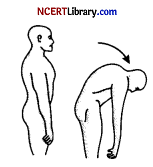
(a) Flexion
(b) Extension
(c) Adduction
(d) Abduction
Answer:
(a) Flexion
Question 2.
____________ is the other name for Vitamin B2. [1]
(a) Niacin
(b) Thiamin
(c) Folic Acid
(d) Riboflavin
Answer:
(d) Riboflavin
Question 3.
__________ is the formula to divide an odd number of teams in the upper half for a knock out fixture. [1]
(a) N+1/2
(b) N-1/2
(c) N(N-1)/2
(d) N(N+1)/2
Answer:
(a) N+1/2
Question 4.
__________ test is developed to test fitness in senior citizens. [1]
(a) Harvard step
(b) Rikli and Jones
(c) AAHPER
(d) Rockport
Answer:
(b) Rikli and Jones
Question 5.
Gliding movement occurs at __________ joint. [1]
(a) Knee
(b) Hip
(c) Wrist
(d) Elbow
Answer:
(c) Wrist
![]()
Question 6.
Consolation tournaments are a part of ___________type of fixture. [1]
(a) Knockout
(b) League
(c) Combination
(d) None of these
Answer:
(a) Knockout
Question 7.
____________amongst these is not a macro mineral. [1]
(a) Calcium
(b) Potassium
(c) Phosphorus
(d) Iodine
Answer:
(d) Iodine
Question 8.
____________discovered Vitamin A? [1]
(a) Dr. Me Collum
(b) Dr. Coubertin
(c) Dr. J.B.Nash
(d) Dr. Harvard
Answer:
(a) Dr. Me Collum
Question 9.
Assertion (A): UNICEF says that water is not included in macronutrients but USDA includes it as part of macronutrients. [1]
Reason (R): Water must be taken in large quantities therefore it can be considered a macronutrient.
(a) Both (A) and (R) are true and (R) is the correct explanation of (A).
(b) Both (A) and (R) are true, but (R) is not the correct explanation of (A).
(c) (A) is true, but (R) is false.
(d) (A) is false, but (R) is true
Answer:
(a) Both (A) and (R) are true and (R) is the correct explanation of (A).
Question 10.
Formula for determining the number of bye in the lower half of a knockout fixture when number of byes are odd? [1]
(a) nb+1/2
(b) nb-1/2
(c) nb/2
(d) nb+1
Answer:
(a) nb+1/2
Question 11.
What is the name of the postural deformity caused due to increase in the curve at the lumbar region? [1]
(a) Knock knees
(b) Bow legs
(c) Kyphosis
(d) Lordosis
Answer:
(d) Lordosis
![]()
Question 12.
Which test is used to test the functional ability amongst senior citizens? [1]
(a) Rockport one mile test
(b) Harvard step test
(c) Rikli and Jones test
(d) Fitness Index score
Answer:
(c) Rikli and Jones test
Question 13.
What is the test duration for the Arm curl test? [1]
(a) 1 min
(b) 2 min
(c) 30sec
(d) Number of repetitions
Answer:
(c) 30sec
Question 14.
Which postural deformity has Convexities right or left? [1]
(a) Flat foot
(b) Knock knees
(c) Kyphosis
(d) Scoliosis
Answer:
(d) Scoliosis
Question 15.
Which motor skill is involved in Smashing volleyball? [1]
(a) Gross motor skills
(b) Fine motor skills
(c) Cross motor skills
(d) Open skills
Answer:
(b) Fine motor skills
Question 16.
Match the following: [1]
| 1. | Vitamin B12 | A. Thiamin |
| 2. | Vitamin B3 | B. Biotin |
| 3. | Vitamin B7 | C. Cobalamin |
| 4. | Vitamin B1 | D. Niacin |
Choose the correct option from the following:
(a) 4 3 1 2
(b) 2 3 4 1
(c) 1 2 3 4
(d) 3 4 2 1
Answer:
(a) 4 3 1 2
Question 17.
Match the following: [1]
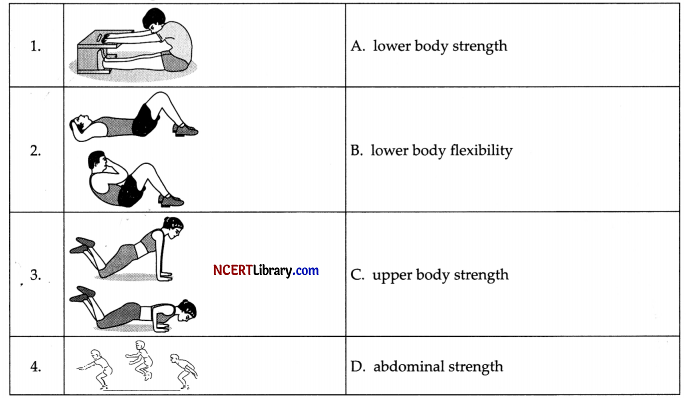
(a) 3 1 4 2
(b) 4 1 3 2
(c) 3 2 4 1
(d) 4 2 3 1
Answer:
(b) 4 1 3 2
![]()
Question 18.
Harvard step is performed to check __________ kind of fitness. [1]
(a) Cardiovascular
(b) Explosive strength
(c) Muscular strength
(d) Reaction ability
Answer:
(a) Cardiovascular
Section-B (10 Marks)
Question 19.
Explain any four benefits of Ardha Matsyendrasana. [2]
Answer:
Benefits of Ardha Matsyendrasana are:
(1) It loses extra fat and makes the body beautiful and strong.
(2) It stimulates the liver, spleen and pancreas.
(3) It is beneficial for the respiratory system.
(4) It strengthens the spinal column and back muscles.
Question 20.
Define explosive strength with the help of an example. [2]
Answer:
Explosive strength is the ability to overcome resistance with high speed. It is used in take-off jumping events like long jump, high jump, triple jump, jumping in volleyball for smashing or spiking, jumping for rebound in basketball.
Question 21.
List any four changes happening in the muscular system due to exercising. [2]
Answer:
Changes happening in the muscular system due to exercising are:
(1) Change in Size and Shape of Muscle: Regular exercise helps in enlarging cells of muscles which in turn helps in changing size and shape of muscles.
(2) Increase in the Strength of Muscles: A person who does exercise daily has stronger muscles and such muscles work more. These become stronger by getting more nutritious food in the form of oxygen.
(3) Increase in Coordination: Regular exercise increases coordination in the muscles. These become stronger by doing exercise. As a result a person does not feel fatigue even by working for a long time.
If the muscles do not have co-ordination or have incomplete co-ordination then the working becomes impossible.
(4) Entrance of Greater Quantity of Oxygen in the Body: Muscles have to do more work during exercise. The consumption of oxygen increases in the person who exercises. Thus blood reaches quickly in the muscles.
Question 22.
What is the meaning of the Isotonic method and it is used for developing which ability? [2]
Answer:
Isotonic Method: Isotonic exercises were introduced by De Lorene in 1954. This term comes from the Greek word ‘iso’ which means ‘same or equal’ maintaining equal (muscle) tone or ‘tension’.
In this one muscle group contracts while the opposite relaxes during which the muscle changes its length. These are those exercises in which direct movements are visible to the 3rd person.
In this case, personal muscular efforts are evidenced by visible movements. In isotonic exercises rapid movements are accomplished by reflex alteration of contraction and relaxation of antagonistic flexors and extensors of the joints concerned.
Type of contraction where we notice the movements of objects is called isotonic contraction, e.g., doing exercise with light weight or dumbbells etc. Most of the exercises fall under this category. Isotonic method is used to develop strength.
Question 23.
What is Laceration and how can it be managed? [2]
Answer:
A laceration is an injury that results in an irregular break in the skin, more commonly referred to as a cut, but defined as a tom and ragged wound. Lacerations are caused when an object strikes the skin and causes a wound to open.
Depending on a variety of characteristics (angle, force, depth, object), some lacerations carl be more serious than others, reaching as far as deep tissue and leading to serious bleeding. The predominant symptoms of lacerations are mild to serious breaking of the epidermis, tears in the first layer of skin that can range from small slices to deep gashes.
Depending on the depth of the laceration, there can be bleeding of different levels of severity. Mild lacerations may experience less bleeding accompanied by mild pain. Deeper lacerations will experience greater bleeding and more intense pain.
Treatment of laceration can be done through following steps:
(1) Stop bleeding at the earliest by compression or by pressing.
(2) Clean the surface of the affected part using water and soap.
(3) Cover the affected part with medicinal cotton bandage or apply band aid.
![]()
Question 24.
List down any four strategies to make physical activities accessible for CWSN. [2]
Answer:
Strategies to make physical activities accessible for CWSN are:
Interest: Physical activities must be based on interest, ability and limitation of children with special needs to ensure maximum participation.
Ability: The physical and mental state of children with special needs shall be considered
Medical Check-up: First, it is mandatory to have a medical check-up of all children with special needs. This is because without that we cannot know about the disability the child is having.
Pre-experiences: Before deciding physical strategies, we shall know the children with their past experiences and convince them.
Section-C (15 Marks)
Question 25.
Create a flowchart to explain classification of sports injuries. [3]
Answer:

Question 26.
List down any two asanas used for preventing Asthma and write the method, benefits and contraindications of any one of them. [3]
Answer:
Asthma disease is associated with the swelling of respiratory tracts, which makes the tracts very sensitive and makes this process pungent with the touch of any effective things.
These reactions cause contractions in the tubes, this reduces the amount of air in the lungs due to which it becomes difficult to breathe. Common symptoms of asthma are coughing, heavy breathing, chest tightness, fatigue, pain in hands, feet, shoulders and back.
Reasons are dust, smoke, pollen grains, animal skin, hair and feather, etc. Asthma can be controlled by Matsyasana, Gomukhasana etc.
Matsyasana: This asana is performed in water body, hence it is called as Matsyasana.
Pre-Stage: Sit in Padmasana pose.
Method:
(1) Take support of your elbow and lie on your back, bend your neck with support of your hands and try to touch your head to the ground.
(2) Hold toes of the feet firmly with both hands and touch ground with the elbows.
(3) Stretch the stomach as up as possible.
Benefits:
(1) This asana is very useful for asthama patient, it provides relief from indigestion and other digestive problems, keeps the blood clean.
(2) Helps in cough and respiratory problems. It makes body and face attractive by bringing natural glow on it. .
Contraindications:
(1) ’Abnormal blood pressure: Individuals suffering from high or low blood pressure should avoid this posture.
(2) Neck injury: Neck injuries or injuries in any part of the lower back or middle back can make it difficult to practice this Fish pose and hence should be avoided.
Question 27.
What are the salient features of the Fartlek training method? [3]
Answer:
The Fartlek method of training was introduced and practiced in Sweden. ‘Fartlek’ is a Swedish term which means ‘speed play’ (playing with speed). This training method was first introduced by Gosta Holmer. It is a type of cross country running.
Fartlek is usually conducted over a hilly region track, and it allows variation in pace. It is one of the best methods of conditioning for most of the sports in which endurance is the basic requirement. This training can be performed at hilly path, river bed, forest, muddy road or sandy path etc. Self-discipline is most important and vital in this type of training.
In Fartlek, the change of pace or speed is not pre-planned so some exercises can also be included in this method. These exercises may be performed by stopping and running temporarily at different intervals. The types of exercises that can be included along with running are hopping, jumping, squat jump, double hop jump etc.
Advantage of Fartlek Training are:
(1) It is an off season training method but is very useful in developing endurance in athletes.
(2) It has a psychological advantage over the other training methods because the changing scenes help in delaying fatigue.
(3) It is the best method to improve endurance in sports where endurance is a basic requirement e.g., cross-country running.
(4) Balancing adjustments of ankles, knees and thighs improves due to the uneven surface.
![]()
Question 28.
Write any three objectives of planning in Sports. [3]
Answer:
The three objectives of planning in sports are:
(1) To reduce unnecessary pressure or immediacy: For conducting any event there should be a proper planning to avoid any rush or immediacy. To organise an event efficiently and smoothly, an organiser needs to prepare a good plan beforehand. Perfect planning will naturally avoid unnecessary pressure.
(2) To keep good control over all the activities: In any planning and management, controlling is the basic principle and objective of planning. In any tournament and competition, an organiser needs to have a good control over all the activities and events related to that particular competition and tournament. Planning helps in keeping a good control in organising a tournament successfully.
(3) To facilitate proper co-ordination: This objective of planning is related to facilitate proper coordination among the various members of committees, formed for organising the competition smoothly. Without proper coordination among the officials of the tournament, it will not be easy to conduct or organise the sports tournament. A proper planning helps in proper coordination.
Question 29.
What is Posture? Give its importance. [3]
Answer:
Posture is essentially the position of the body in space, the relationship of the body parts: head, trunk and limbs to each other. Changes in posture occur when any part of the body is moved.
Posture communicates non-verbal body language, reflecting self-esteem and mental balance. The ideal posture is the state of muscular and skeletal balance.
Following are the importance of a good posture:
(1) Improves overall appearance and is a confidence booster. Having good posture will help you look and feel more glamorous, more alive and keep your body healthier.
(2) It aids indigestion.
(3) It strengthens, energises and revitalises the body.
(4) Prevents fatigue as muscles are used more efficiently.
(5) Helps to prevent back and neck pain. It lowers the strain level on ligaments.
(6) Feels good to have body in balance.
Question 30.
Give the sources and functions of important minerals in our body. [3]
Answer:
Source and Functions of Minerals are:
| Mineral | Sources | Function |
| Sodium | Table salt, soy sauce; large amounts in processed foods; small amounts in milk, breads, vegetables, and unprocessed meats. | Needed for proper fluid balance, nerve transmission, and muscle contraction. |
| Chloride | Table salt, soy sauce; large amounts in processed foods; small amounts in milk, meats, breads, and vegetables. | Needed for proper fluid balance, stomach acid. |
| Potassium | Meat, milk, fresh fruits and vegetables, whole grains, legumes. | Needed for proper fluid balance, nerve transmission, and muscle contraction. |
| Calcium | Milk and milk products; canned fish with bones (salmon, sardines), fortified tofu and fortified soy milk, greens (broccoli, mustard greens); legumes. | Important for healthy bones and teeth; helps muscles relax and contract; important in nerve functioning, blood clotting, blood pressure regulation, immune system health. |
| Phosphorus | Meat, fish, poultry, eggs, milk, processed foods (including soda pop). | Important for healthy bones and teeth; found in every cell; part of the system that maintains acid-base balance. |
| Magnesium | Nuts and seeds, legumes, leafy, green vegetables, seafood, chocolate, artichokes, “hard” drinking water. | Found in bones; needed for making protein, muscle contraction, nerve transmission, immune system health. |
| Sulphur | Occurs in foods as part of protein: meats, poultry, fish, eggs, milk, legumes, nuts. | Found in protein molecules. |
Section-D (12 Marks)
Question 31.
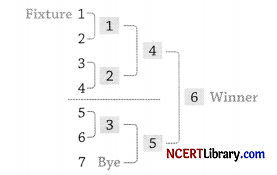
On the basis of above given fixture answer the following questions: [4]
(a) ________ is a scheduled match for any competition or any tournament.
(b) How many matches will be played in the above fixture?
(c) What type of fixture is given above?
(d) _________will be total number of byes will be there?
OR
A league fixture may be represented by a ________method.
Answer:
(a) Fixture
(b) 6
(c) Knockout fixture
(d) 1
OR
cyclic or staircase
![]()
Question 32.
Physical education teacher of ABC school was teaching the students about Newton’s Laws of Motion. [4]

(a) While explaining he showed the students this picture and tried to explain how there is a difference in the speed of an object due to their weight. Can you name the Law?
(b) Every reaction has equal and opposite _________.
(c) “A body at rest will remain in rest and a body in motion will remain in motion at the same speed and in the same direction unless acted on by some _________ “.
(d) “A change in velocity (acceleration) of an object is directly proportional to the force producing it and ___________ proportional to its mass”.
OR
Everything that moves is governed by laws of motion formulated by whom?
Answer:
(a) Newton’s second law of motion
(b) Reaction
(c) External force
(d) Inversely
OR
Sir Isaac Newton.
Question 33.
In relation to the picture, answer the following questions: [4]
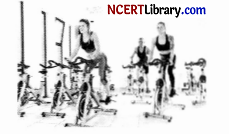
(a) What type of exercise is shown in the picture given above?
(b) A machine that controls the speed of ________within the range of motion is used.
(c) Which kind of machines provide these exercises?
(d) ________exercise is similar isokinetic exercise in sports.
Answer:
(a) Isokinetic exercises
(b) Contraction
(c) Cybex and Biodex
(d) Ice skating
Section-E (15 Marks)
Question 34.
Briefly explain the administration of Pawanmuktasana along with its contraindications and draw stick diagram. [5]
Answer:
Procedure and contraindications of Pawanmuktasana are:
Procedure of the Pawanmuktasana are:
(1) Lie on your back with your feet together and arms besides your body and relax, breathing deeply.
(2) With a deep inhalation raise your legs to 90° and completely exhale.
(3) Now with another inhalation bring both the knees close to your chest and press on the lower abdomen, holding the knees with your hands. Exhale completely.
(4) Remain with bent knees for a few breaths. With every exhalation press the thighs and knees on the abdomen and hold them with your hands.
(5) With a deep breath raise your head, neck and chest and bring them close to your knees. If possible, bring your chin in between your knees. Ensure the head moves less and the knees come closer to the face.
That way the pressure on the abdominal muscles will help in releasing the unwanted gas or wind around the abdominal organs.
(6) Remain in this posture for a few breaths focusing on maintaining the position of the head and neck in place. With every exhalation press the thighs closer and deeper into the chest and face deeper into the knees.
(7) Try to maintain the balance while breathing slowly and keeping the body relaxed.
(8) Now with an inhalation, release the neck and head and exhale completely. With another inhalation straighten the legs and bring them back to 90° and as you exhale release the leg from 90° to the relaxed posture.
With complete exhalation, bring the legs stretched out on the floor and relax the neck.
(9) Take a few breaths, and then continue with the next round. The longer you hold in this posture the faster the muscles around the abdomen loosen.
Contraindications of the Pawanmuktasana are:
To be avoided or performed under guidance by those suffering from:
(1) severe migraine
(2) high or low blood pressure
(3) asthma
(4) slip disc
(5) advanced stages of spondylitis
(6) Girls or Women should avoid this asana or take the guidance of the teacher while practicing it during the menstrual cycle.
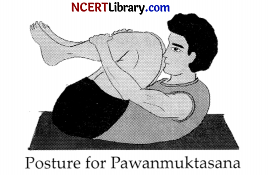
![]()
Question 35.
“Involvement in physical activities for longer period of time with moderate intensity can improve the quality of life.” Justify your answer. [5]
Answer:
Involvement in physical activities for longer period of time with moderate intensity can improve the quality of life in the following ways:
Exercise Helps in Healthy Growth and Development: Exercise is an important part of keeping children healthy. Encouraging healthy lifestyles in children and adolescents is important when they grow older. Participating in organised sports and games is not only of great fun but is very essential for healthy growth and development.
Exercises Improve Self-esteem: Exercise is necessary for the physical and mental health. Self esteem can play a great role in how children feel about themselves and also how much they enjoy things or worry about things. Exercise reduces depressive symptoms and improves self-esteem in children.
Enhances Flexibility: The stiffness of joints decreases due to exercising, in a way improving the flexibility. The elasticity of tendons, ligaments and joint capsules improves due to regular exercise.
Lessens Stress and Tension: Regular exercise has a distinctive capability to slow down the depression process by reducing stress and tension. Actually, regular exercise lessens the levels of body’s stress hormones like adrenaline and cortisol.
The body’s natural painkillers and mood elevators i.e., the endorphins are produced due to regular exercise. These benefits of work out facilitate in delaying the process of aging.
Connect with Others: Spend time with positive people who enhance your life by instilling in you with positive thoughts. A strong support system will buffer you from the negative effects of stress.
Keep Your Sense of Humour: This includes the ability to laugh oneself. The act of laughing helps the body to fight stress in a number of ways.
Question 36.
Define ectomorphs and give their basic traits. [5]
Answer:
The individuals who have an ectomorph body are usually referred to as slim persons because their muscles and limbs are elongated. They have a weak constitution of body and usually face great difficulties in gaining weight. They have a quick metabolism to burn fat. They also have a tendency to stick with what they do best. Their light body constitution makes them suited for aerobic activities like gymnastics.
Traits of Ectomorph are:
(1) They are lean, tall and thin.
(2) They are lightly muscled.
(3) They have a flat chest.
(4) They have long neck, fingers and toes.
(5) They have soft and thin skin.
(6) They have weak strength.
(7) They suffer from increased heat, due to low body fat.
(8)They have good hair which grows quickly.
(9) They can lose weight easily and find it difficult to gain weight.
(10) They stay slim, because of their higher metabolic rates.
(11) They do not recover fast after fatigue.
(12) They have poor sleep and anxiety.
(13)They feel suffocated with people around.
(14)They are introverts.
![]()
Question 37.
Explain the purpose, procedure, advantages and disadvantages of the Continuous method of training. [5]
Answer:
Purpose: The simplest form of training. This type of training is a good way to improve the aerobic energy system. Swimming, running and cycling are common examples of continuous training activities.
Procedure: As the name suggests, it involves training with no rest periods or recovery intervals. One needs to work for a minimum of 20 minutes to achieve some kind of benefit.
As fitness improves, one will also be able to sustain a higher level of intensity. Start training at about 60% of maximum heart rate (MHR) increasing to around 75%-80% as the level of fitness improves. Continuous training depletes carbohydrate storage. As the body needs an energy supply to keep working, it is forced into using fat supplies.
This means that continuous training is a good way to bum fat and lose weight. Continuous training does not just mean running. Aerobics is a popular form of continuous training. It is usually performed to music and requires the performer to coordinate whole body movements.
Advantage: With the endurance method, one can improve maximum oxygen intake. The more oxygen one takes in, the more energy body will have and therefore, the longer one can run before muscles get tired.
This type of training is with long-lasting stress and constant intensity without any breaks. A workout of 30 minutes (for beginners) will be good and it can comfortably reach 2 hours (for more experienced runners).
Disadvantage: The main drawback of continuous training is that it does not improve speed or agility. This means it is not ideal for games, players who need to be able to change pace. Continuous training can also be extremely boring. Some participants find longer sessions to be boring.